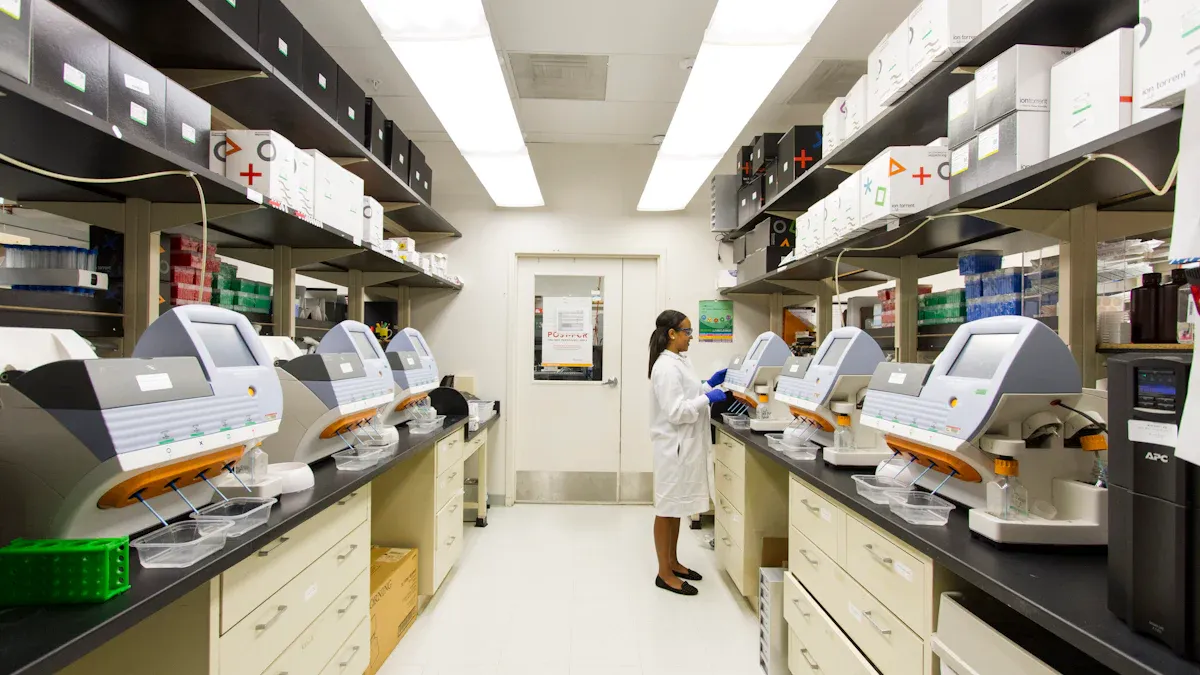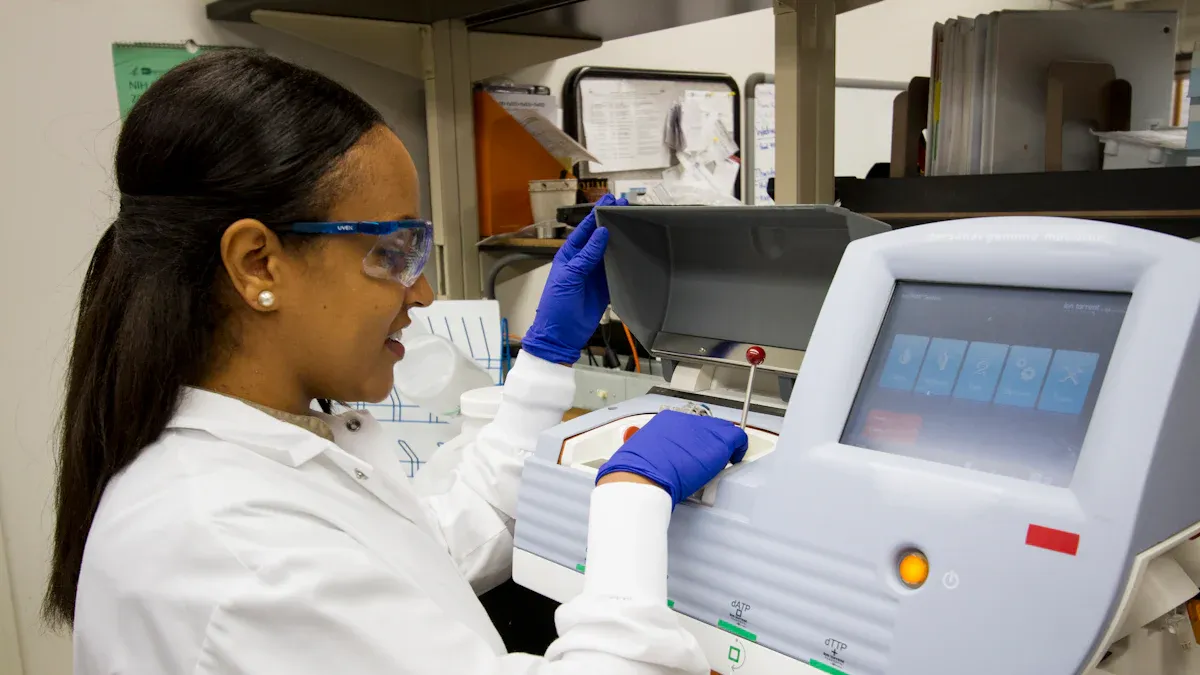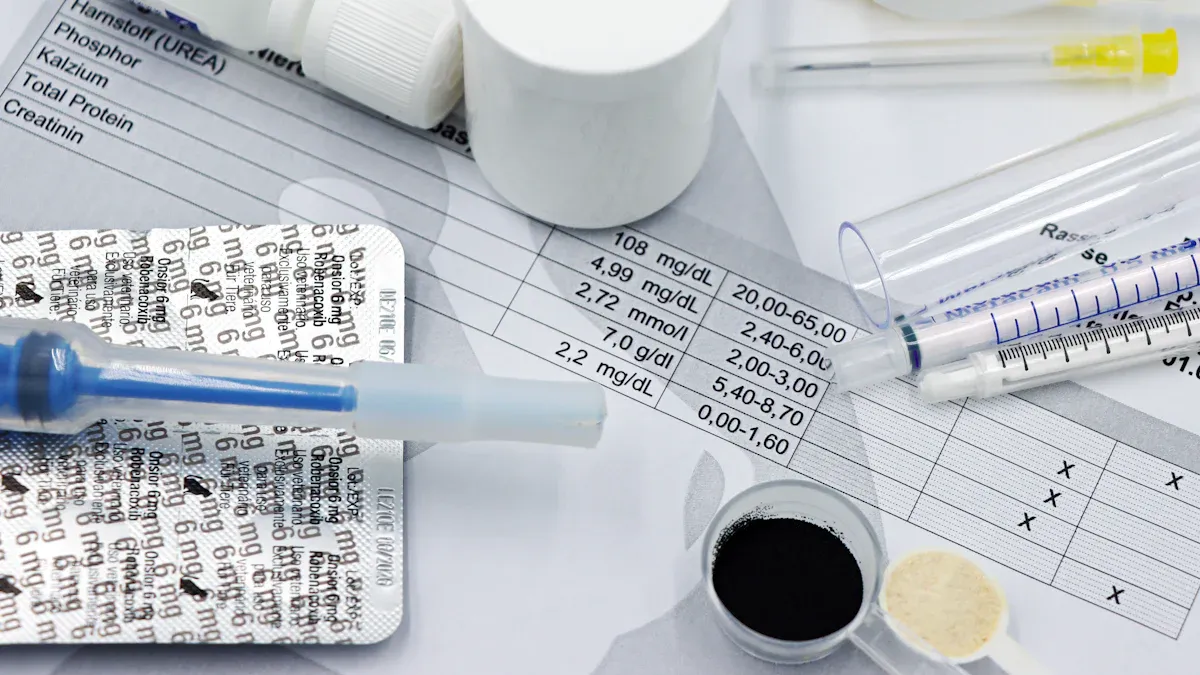What Are the Applications of Next-Generation Sequencing in Cancer Research

Next-generation sequencing (NGS) has revolutionized how you understand cancer at the genetic level. This advanced technology identifies mutations and biomarkers, enabling more precise treatments tailored to individual patients. For instance, comprehensive genomic profiling (CGP) can detect genetic changes, such as secondary mutations in the EGFR gene, that cause resistance to specific therapies. By adjusting treatment plans based on these findings, oncologists can improve outcomes for patients like you or your loved ones.
NGS also plays a key role in liquid biopsies. It helps detect circulating tumor DNA (ctDNA), which is present in over 75% of patients with advanced cancers like pancreatic or colorectal cancer. This approach offers a non-invasive way to monitor disease progression. As you explore the applications of NGS, you'll see how it empowers researchers in decoding the DNA: Next-Generation Sequencing in Cancer Studies, transforming cancer care and saving lives.
Key Takeaways
Next-generation sequencing (NGS) finds gene changes and markers. This helps doctors create better cancer treatments for each person.
Liquid biopsies with NGS check cancer without surgery. They give useful information without needing tissue samples.
NGS helps make cancer treatments fit each patient’s tumor. This makes treatments work better and causes fewer problems.
NGS can spot cancer early by finding gene changes. It helps doctors act quickly before symptoms show up.
New NGS tools are cheaper and easier to use. This helps more people get better cancer care.
Decoding the DNA: Next-Generation Sequencing in Cancer Studies

What Is Next-Generation Sequencing?
Next-generation sequencing (NGS) is a powerful technology that allows you to read and analyze DNA or RNA sequences quickly and accurately. Unlike older methods, NGS can process millions of DNA fragments simultaneously, making it faster and more efficient. This technology is widely used in cancer research to uncover genetic mutations and patterns that drive cancer development.
Several authoritative databases provide valuable resources for NGS in cancer studies. For example:
Database | Description |
|---|---|
COSMIC | A repository of over 23 million mutations, focusing on cancer gene mutations from literature and genome resequencing studies. |
TCGA | A comprehensive resource for clinical and genomic data across various cancers, including raw sequencing data. |
OncoKB | An oncology database detailing genetic mutations, drug usage, and clinical implications. |
These databases help you understand how genetic changes influence cancer and guide the development of targeted therapies.
How Does NGS Work in Cancer Research?
NGS involves several steps to decode the DNA of cancer cells. The process begins with DNA fragmentation, where the DNA is broken into smaller pieces. These fragments are then prepared for sequencing by adding adapters and amplifying the DNA. Afterward, the DNA is sequenced, and the data is analyzed to identify mutations and other genetic changes.
Here’s a simplified breakdown of the process:
DNA is fragmented and prepared with adapters.
PCR amplification enriches the target DNA.
The DNA library is sequenced using advanced platforms like Novaseq.
Data is processed to identify mutations, such as SNPs and InDels.
NGS has proven to be highly effective in cancer research. For instance, GeneLLM achieved an AUC of 0.96 for pan-cancer detection, outperforming previous methods. It also demonstrated exceptional accuracy in detecting pancreatic cancer, with an AUC of 0.99. These advancements highlight the efficiency and cost-effectiveness of NGS in identifying cancer-related genetic features.
By decoding the DNA of cancer cells, NGS provides insights that help you understand the disease better and develop more precise treatments.
Key Applications of NGS in Cancer Research

Identifying Genetic Mutations and Biomarkers
Next-generation sequencing (NGS) helps you uncover genetic mutations and biomarkers that drive cancer. By analyzing the DNA of cancer cells, NGS identifies specific changes that contribute to tumor growth. These insights allow researchers to classify cancers more accurately and develop targeted therapies.
For example:
In a case of salivary gland carcinoma (SGC), NGS detected a GPHN-ALK variant. This discovery led to successful treatment with alectinib, a drug not originally intended for this cancer type.
Another case involved a spindle cell neoplasm. NGS revealed a PIK3CA mutation, enabling doctors to add alpelisib to the treatment plan. This approach stopped the disease from progressing.
These examples show how NGS provides actionable information, helping you and your healthcare team make better decisions. By decoding the DNA: Next-Generation Sequencing in Cancer Studies, you can identify genetic markers that guide treatment and improve outcomes.
Personalized Cancer Treatments
NGS plays a vital role in personalizing cancer treatments. It allows you to understand the unique genetic makeup of a tumor, enabling doctors to select therapies tailored to your specific needs. This approach improves the effectiveness of treatments and reduces unnecessary side effects.
Here’s how NGS supports personalized care:
It provides a comprehensive profile of your tumor, identifying actionable mutations.
It evaluates multiple genes at once, minimizing the need for repeat biopsies.
It identifies molecular markers that guide treatment selection, opening doors to clinical trials and advanced therapies.
For patients with advanced cancers, NGS has become a standard tool. It identifies hundreds of potential treatment targets, ensuring you receive the most effective options. For instance, patients with non-small cell lung cancer (NSCLC) benefit from targeted therapies identified through NGS. The National Comprehensive Cancer Network now recommends molecular testing for all patients with metastatic NSCLC to guide treatment decisions.
By decoding the DNA: Next-Generation Sequencing in Cancer Studies, NGS empowers you with personalized treatment plans that improve your chances of recovery.
Cancer Diagnosis and Early Detection
Early detection is crucial in cancer care, and NGS offers a powerful tool for diagnosing cancer at its earliest stages. By analyzing genetic material, NGS can detect mutations and alterations that signal the presence of cancer, even before symptoms appear.
Liquid biopsies, a non-invasive method, use NGS to analyze circulating tumor DNA (ctDNA) in your blood. This technique helps identify cancers like pancreatic or colorectal cancer in their early stages. It also allows for real-time monitoring of tumor progression, giving you and your doctor valuable insights into how well treatments are working.
NGS also enhances the accuracy of cancer diagnoses. By identifying specific genetic mutations, it helps doctors distinguish between different cancer types. This precision ensures you receive the right diagnosis and the most effective treatment plan.
With its ability to decode the DNA: Next-Generation Sequencing in Cancer Studies, NGS is transforming how you detect and diagnose cancer, offering hope for earlier interventions and better outcomes.
Monitoring Disease Progression and Recurrence
Monitoring cancer progression and recurrence is critical for improving patient outcomes. Next-generation sequencing (NGS) offers a powerful tool to track changes in your cancer over time. By analyzing genetic material, NGS helps detect minimal residual disease (MRD), monitor treatment responses, and identify early signs of recurrence. This approach provides a more precise and dynamic way to manage your care compared to traditional methods.
One of the most promising applications of NGS is the use of circulating tumor DNA (ctDNA) to monitor disease progression. ctDNA, which comes from dying cancer cells, circulates in your bloodstream and reflects the genetic makeup of your tumor. By analyzing ctDNA, doctors can track how your cancer evolves and adjust treatments accordingly. Studies have shown that ctDNA dynamics often correlate with the clinical course of the disease. For example, higher levels of ctDNA variants were observed during disease progression, providing valuable insights into how your cancer responds to therapy.
Here’s a summary of findings from longitudinal studies on ctDNA monitoring:
Finding | Description |
|---|---|
ctDNA-positive rate | Did not differ according to primary tumor subtype or disease-free interval (DFI) (P = 0.458). |
58.3 months in ctDNA-positive patients vs. 38.6 months in ctDNA-negative patients. | |
ctDNA detection | No significant difference in detection rates between anchor mutations from paired target sequencing and primary tumor sequencing (100% vs 75%, P = 0.515). |
eVAF dynamics | Correlated with clinical course; higher mean eVAF identified at disease progression. |
Previous studies | Demonstrated correlation of ctDNA dynamics with treatment response in various cancers. |
NGS also enhances patient monitoring by providing more accurate and comprehensive data compared to traditional methods. For instance:
It achieves a concordance rate of over 70% with clinical diagnostic results.
It identifies pathogenic microorganisms effectively, aligning with culture and imaging tests.
It matches drug resistance results with drug sensitivity tests in approximately 65% of cases.
These capabilities make NGS a reliable tool for tracking your cancer’s progression and tailoring treatments to your needs. Unlike conventional approaches, which often rely on imaging or biopsies, NGS provides a non-invasive and detailed view of your cancer’s genetic landscape. This allows doctors to make informed decisions and intervene earlier when necessary.
By decoding the DNA: Next-Generation Sequencing in Cancer Studies, you gain access to cutting-edge technology that empowers you and your healthcare team to stay ahead of the disease. This proactive approach improves your chances of long-term survival and enhances your quality of life.
Emerging Trends and Future Potential of NGS
Liquid Biopsies and Non-Invasive Testing
Liquid biopsies are transforming cancer research by offering a non-invasive way to detect and monitor cancer. Instead of relying on traditional tissue biopsies, liquid biopsies analyze circulating tumor DNA (ctDNA) or other biomarkers in your blood. This method provides faster results and reduces the discomfort associated with invasive procedures.
Studies highlight the effectiveness of liquid biopsies:
Study | Findings |
|---|---|
NILE trial (NCT03615443) | |
Li et al. | Found higher methylation levels in plasma from breast cancer patients compared to healthy controls. |
Shimomura et al. | Identified five miRNAs that detect breast cancer with high sensitivity and specificity. |
These advancements make liquid biopsies a promising tool for early detection, diagnosis, and monitoring of cancer progression.
AI and Machine Learning in NGS Data Analysis
Artificial intelligence (AI) and machine learning (ML) are revolutionizing how you analyze NGS data. These technologies process large datasets quickly, uncovering patterns and relationships that traditional methods might miss. AI enhances the accuracy of identifying genetic mutations and biomarkers, enabling earlier diagnoses and more precise treatments.
Application Area | Description |
|---|---|
Genomic Data Analysis | |
Treatment Personalization | AI helps tailor therapies to your tumor’s unique molecular profile. |
Biomarker and Mutation Identification | AI reveals actionable mutations for targeted therapies. |
Data Management and Analysis | AI accelerates data processing and clinical trial participant selection. |
As AI tools improve, they will make NGS data analysis faster and more reliable, helping doctors make confident treatment decisions.
Expanding Accessibility of NGS in Clinical Settings
Next-generation sequencing is becoming more accessible in clinical settings, benefiting patients like you. Advances in technology have reduced costs and increased speed. What once took years and billions of dollars during the Human Genome Project can now be done in hours for about $1,000.
In clinical studies, NGS has shown remarkable utility:
Study Description | Key Findings |
|---|---|
Clinical sequencing in the Deep South | |
Exome sequencing in Colorado & Oregon | Provided insights into cancer predisposition. |
Genomic sequencing in NYC children | Addressed undiagnosed pediatric disorders. |
The growing use of molecular tumor boards also ensures that complex genomic data is interpreted effectively, leading to better treatment outcomes. As NGS becomes more affordable and widespread, it will play a crucial role in improving cancer care for diverse populations.
Next-generation sequencing (NGS) has transformed cancer research by uncovering the genetic drivers of the disease. It empowers you with tools for personalized treatments, early detection, and precise monitoring, improving outcomes and shaping the future of oncology. Molecular tumor boards (MTBs) further enhance NGS’s impact by tailoring therapies based on molecular data.
Findings | Description |
|---|---|
Molecular Tumor Boards | MTBs recommend targeted therapies by analyzing molecular alterations. |
Clinical Effectiveness | MTB referrals expand access to innovative treatments beyond standard care. |
Treatment Recommendations | MTBs suggest clinical trials and off-label therapies for personalized care. |
As NGS technology advances, its potential to revolutionize cancer care grows, offering hope for better diagnostics and treatments.
FAQ
What makes NGS different from traditional sequencing methods?
NGS processes millions of DNA fragments simultaneously, making it faster and more efficient than traditional methods like Sanger sequencing. It provides comprehensive insights into genetic mutations, enabling you to analyze entire genomes or specific regions in a single run.
Can NGS detect all types of cancer?
NGS identifies genetic mutations linked to many cancer types. However, its effectiveness depends on the availability of known biomarkers for specific cancers. It works best when combined with other diagnostic tools to provide a complete picture of your condition.
How reliable is NGS for cancer diagnosis?
NGS offers high accuracy in detecting genetic mutations and biomarkers. Studies show it achieves over 95% concordance with traditional diagnostic methods. Its ability to analyze ctDNA also enhances early detection and monitoring, making it a reliable tool for cancer care.
Is NGS testing covered by insurance?
Many insurance providers cover NGS testing, especially for advanced cancers or when it guides treatment decisions. Coverage depends on your location, insurance plan, and the specific test. Check with your provider to confirm eligibility.
How long does it take to get NGS results?
NGS results typically take 1 to 3 weeks, depending on the complexity of the test and the laboratory's capacity. Some advanced platforms may deliver results faster, helping you and your doctor make timely treatment decisions.
See Also
Exploring Molecular Characteristics of Lung Giant Cell Carcinoma
An In-Depth Overview of Various Cancer Types Available
Insights Into Large-Cell Lung Carcinoma and Its Types
Recognizing Symptoms and Treatment Options for Duodenal Cancer
Key Information Regarding Basaloid Squamous Cell Lung Carcinoma
